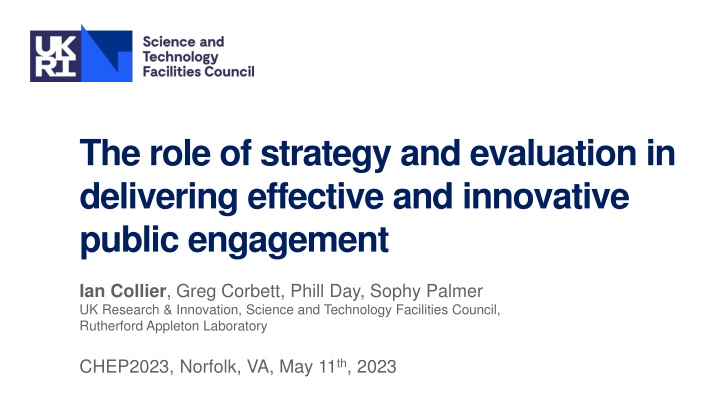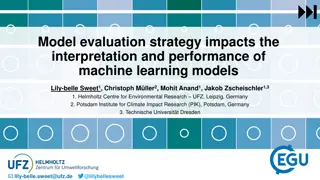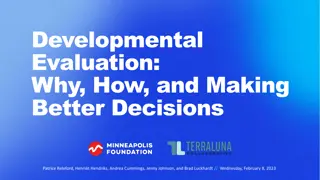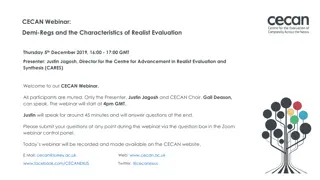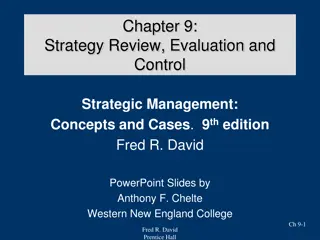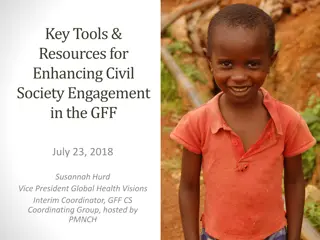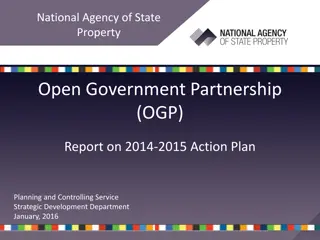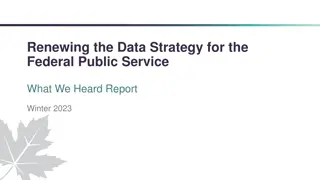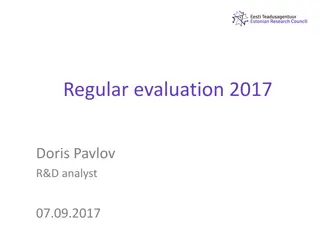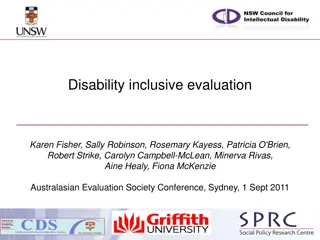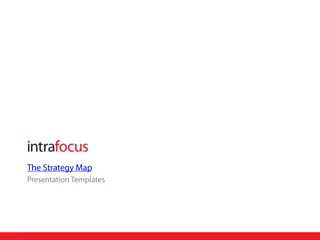Enhancing Public Engagement through Strategy and Evaluation
Explore the effective role of strategy and evaluation in public engagement, presented by experts from UK Research & Innovation. Discover the mission of STFC's National Labs PE and their aims in showcasing science, building partnerships, supporting STEM influencers, reaching diverse audiences, and delivering quality activities. Learn about the Science Capital concept's impact on youth engagement in science careers and efforts to increase science capital. Dive into a discussion on fostering innovation and inclusivity in public engagement initiatives.
Download Presentation

Please find below an Image/Link to download the presentation.
The content on the website is provided AS IS for your information and personal use only. It may not be sold, licensed, or shared on other websites without obtaining consent from the author.If you encounter any issues during the download, it is possible that the publisher has removed the file from their server.
You are allowed to download the files provided on this website for personal or commercial use, subject to the condition that they are used lawfully. All files are the property of their respective owners.
The content on the website is provided AS IS for your information and personal use only. It may not be sold, licensed, or shared on other websites without obtaining consent from the author.
E N D
Presentation Transcript
The role of strategy and evaluation in delivering effective and innovative public engagement Ian Collier, Greg Corbett, Phill Day, Sophy Palmer UK Research & Innovation, Science and Technology Facilities Council, Rutherford Appleton Laboratory CHEP2023, Norfolk, VA, May 11th, 2023
Who am I? Group Leader UKRI/STFC s Scientific Computing Department (SCD) at RAL Work focusses on enabling computing federations System administration background Actively involved in PE since I joined STFC 14 years ago Chair departmental Public Engagement Committee Supported by National Labs PE team 2
Some Context This talk somewhat follows on from Greg Corbett s talk in Adelaide https://indico.cern.ch/event/773049/contributions/3478368/ Also see Greg s poster, A return to in-person public engagement at STFC , this afternoon https://indico.jlab.org/event/459/contributions/11712/ I ll try not to repeat too much
STFCs National Labs PE Our Vision A society that values and participates in scientific endeavour. Our Mission Using our stories, community and facilities to inspire and involve people with our science and technology.
Our aims 1 Showcase STFC science and technology Using our facilities, stories and community to inspire 2 Build the right partnerships Improving our reach and impact 3 Develop and support STEM influencers Creating a network of people passionate about STEM 4 Improving our reach with diverse audiences A focus on Wonder communities the 40% most deprived areas of the UK 5 Delivering high quality activities Making an impact on our audiences
Science Capital Concept that helps us understand why some young people participate in post-16 science and others do not. Helps shed light on why particular social groups remain under- represented and why many young people do not see science careers as being for me . We re choosing to prioritise activities that do the most to increase science capital and working with communities who have lower science capital Find out more from the STEM Learning Centre https://www.stem.org.uk
Public Engagement Wonder Initiative One part of the 2016-2021 strategy was to better target our efforts Science and technology can inspire (and should involve) people from all backgrounds. But we know that the playing field isn t level. STFC s Wonder Initiative focuses on working with participants from the 40% most socio-economically deprived areas of the UK. Within this group, we target 8 to14 year-olds Research shows that low science capital at this age shapes a young person s outlook and could dissuade them from a career in science, technology, engineering or maths (STEM).
How do we know what were achieving? Public Engagement Evaluation Framework Applied generic learning outcomes (GLOs) tailored to STFC s purposes Specifying what we intend the activity to achieve Evaluating what participants will do, feel, value, understand, and the skills they acquire. Does the activity achieve what we intend? Part of overall move to better understand impact of our PE Helps us be clear and consistent in how we report, improve, and celebrate our work. Find STFC s evaluation framework at: http://www.stfc.ac.uk/public-engagement/strategy-and-evaluation/evaluation-and-our-evidence-base/
New approaches to PE In 2020/2021 just as our technical work went online and remote we also had to pause face to face PE activities A clear strategy and being used to working with the idea of GLOs helped us very quickly plan and implement new activities. We were able to significantly improve some aspects of our strategic goals. Ran 200 events, reaching 34,000 participants Improved reach with schools from Wonder areas the 40% most deprived communities of the UK. Outcomes: 95.3% of participants gave activities a satisfaction rating of at least 4 out of 5. 98.9% of the public audience reported the activities encouraged them to value STEM or STEM careers. 93.2% of the school students, including 97.5% of those identifying as female, said activities encouraged them to consider studying or working in STEM in the future.
Some examples Remote3 Remote sensing by Remote schools in Remote environments Already being planned before the pandemic We were able to adapt to to be completely remote Work Experience Python Workshop Well established in person pivoted to remote Halton Coding Clubs New project targeting schools with lower science capital near Daresbury Laboratory
Remote3 Remote sensing by Remoteschools in Remote environments Collaboration between staff from the University of Edinburgh, from STFC's Public Engagement team, Boulby Underground Laboratory and Scientific Computing (SCD). Remote3 provides school groups with a LEGO Mindstorms kit They design and program their own Mars Rover Rovers are shipped to the Boulby Underground Laboratory s Mars Yard Complete a series of defined space-exploration themed challenges via a live video connection.
Brae High School Remote3 The Teams Anderson High School Kirkwall Grammar School Remote3 aims to support schools with lower science capital Sir E. Scott School Initially this was a selection of schools located in more-remote areas of Scotland, but for 22-23 has expanded to include schools in England Dornoch Academy Each school receives support from a mentor a volunteer from the University of Edinburgh, STFC Boulby, or STFC Scientific Computing Mintlaw Academy Plockton High School Design and programming runs over several months Inverurie Academy Live-broadcast testing day, hosted at RAL Space, at the Rutherford Appleton Laboratory Partnership, providing sustained support to young people who would be unlikely to visit our facilities in person Carluke High School Lockerbie Academy Boulby Underground Laboratory
Work Experience Python Workshop Preparation for work experience placements Used to be in person for 10-20 (teenage) participants Translated to jupyter notebooks running on STFC cloud Now reaching 70-100 participants each year Much broader geographic reach Participants no longer need be able to get to the lab The jupyter based materials also work really well in person The framework (we call Monty) being used for other topics 13
The Halton Project: What we are doing Engaging Primary School pupils and teachers Appropriate, exciting child-friendly resources promoting engineering, computing, coding, creativity, and innovation throughout KS1 and KS2 (elementary school) Training for teachers to embed provision in schools (with further activities for teachers post visit) Resource sharing network between schools Engaging Secondary School pupils and teachers through Pre-recorded online content generated by our staff Online STEM Ambassador engagement Promotion of Work Experience opportunities Utilising partnership work to provision additional out of school opportunities in Halton Coding Clubs funded by HBC, led by MakoCreate, supported by our staff Community Centre and Childrens Centre STEM events focussed on families with children enabling access where financial and/or confidence barriers might be a problem
Halton Coding Clubs Percentage of Attendees at Halton Code Clubs by IMD Decile (Line represents Wonder Audience) IMD1 = Most Deprivation, IMD10 = Least Deprivation 100.00% 0.00% 0.00% 0.00% 5.68% 7.14% 7.14% 11.53% 12.50% 13.33% 13.33% 0.00% 14.29% 90.00% 9.09% 0.00% 0.00% 0.00% 14.29% 6 Code Clubs Delivered 2 per month 3 in Runcorn 3 in Widnes Reaching 88 Young People Of whom: 23 Female aged 8-14 60 Male aged 8-14 4 Female aged 15-18 1 Male aged 15-18 Supported by 4 STFC STEM Ambassadors and 1 Runcorn Councillor 6.25% 2.27% 9.08% 0.00% 80.00% 13.33% 28.57% 0.00% 14.29% 20.00% 6.54% 18.18% 18.75% 70.00% 6.62% 21.43% 7.14% 13.33% 4.37% 61.85% 57.14% 54.55% 60.00% 57.14% 57.14% 7.14% 7.14% 60.00% 10.23% 5.42% 50.00% 0.00% 0.00% 0.00% 0.00% 20.00% 12.50% 7.14% 7.14% 13.33% 46.67% 8.05% 5.68% 50.00% 14.29% 0.00% 0.00% 9.09% 12.50% 14.29% 40.00% 21.43% 22.65% 20.00% 20.00% 17.05% 12.50% 30.00% 14.29% 42.86% 20.00% 12.50% 20.00% 28.57% 26.67% 25.73% 22.73% 21.43% 10.00% 12.50% 6.67% 0.00% Evaluation will allow us to measure outcomes IMD1 IMD2 IMD3 IMD4 IMD5 IMD6 IMD7 IMD8 IMD9 IMD10 % Wonder Indices of multiple deprivation (IMD) are widely-used datasets within the UK to classify the relative deprivation(essentially a measure of poverty) of small areas.
Summary Developing a clear strategic framework has allowed PE STFC s National Labs PE team to plan and coordinate a program of activities tailored to meet specific requirements. Adopting a framework for evaluating our activities has allowed us to better understand if and how we are meeting those strategic priorities Together they help us in planning innovative approaches to working with communities that were less likely/able to come to us When we had to suspend F2F PE this structure helped us quickly pivot to new online activities Significant improvement in reaching Wonder/lower science capital audiences Some of the more detailed evaluation is rather harder with remote work Emphasis on using evidence to target and improve our work We re now integrating the activities into a richer hybrid PE program
Science and Technology Facilities Council @STFC_Matters Science and Technology Facilities Council
